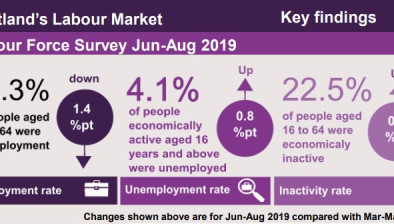Scotland’s quarterly jobless rate climbs as wage growth eases

Scotland’s unemployment rate rose to 4.3% in the three months to March 2025, an increase of 0.5 percentage points from the previous quarter, according to Office for National Statistics (ONS) data.
This figure, representing 119,000 people, remains below the UK average of 4.5% and is a 0.2 percentage point decrease compared to the same period in 2024.
Conversely, the employment rate for those aged 16 and over increased by 0.4 percentage points to 74.5%, with 2,662,000 people in work. However, separate HMRC estimates for April 2025 indicated a decrease in payrolled employees by 12,000 year-on-year and 3,000 on the previous month, totalling 2.45 million. Median monthly pay for these employees rose by 5.8% annually to £2,533.
Deputy First Minister Kate Forbes described Scotland’s labour market as “resilient”, whilst Scottish Secretary Ian Murray called for more action to help people into work.
Experts suggest the figures depict a weakening market, exacerbated by rising employee costs from National Insurance contributions (NICS) and minimum wage increases in April. These pressures are reportedly affecting worker demand and leading to job cuts. Economists believe that moderating salary rises could help control inflation, potentially paving the way for further interest rate cuts by the Bank of England, which recently lowered rates to 4.25%. However, a BoE official cautioned that wage growth might still be too rapid to sustainably meet the 2% inflation target.
Kevin Brown, savings specialist at Scottish Friendly, said: “On the surface, ONS wage data continues to give UK households some reason for cheer.
“Pay rises are still climbing ahead of inflation, in a boost to household disposable income for many. Wages continue to defy the relatively gloomy prognosis for the UK economy, but the rate is slowing relative to inflation.”
He continued: “The data does not yet capture the impact of either the National Insurance rises and living wage increase, which started in April, nor the drama created by US tariffs and their impact here in the UK.
“There are signs that wage growth will slow further from here. Business confidence is at its lowest level since the Covid pandemic. Private sector headcount growth has slowed to a snail’s pace, while headcount is expected to fall among public sector workers.
“Equally, ONS data shows household disposable income remains stagnant since 2008 as cost of living increases have continued to all but wipe out any pay rises. Against this backdrop, households are unlikely to be feeling much better off in spite of some decent wage hikes.
“Households will need to continue to make sure their money goes as far as possible, and that extends to nest eggs. Finding the right ‘home’ for the money they are putting aside for the long-term is crucial.”








